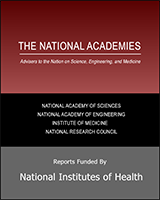NCBI Bookshelf. A service of the National Library of Medicine, National Institutes of Health.
Excerpt
In response to a congressional request in the Health and Human Services (HHS) fiscal 2002 appropriations act, the Board on Children, Youth, and Families of the National Research Council and the Institute of Medicine formed the Committee on Developing a Strategy to Reduce and Prevent Underage Drinking. The committee was directed to review a broad range of federal, state, and nongovernmental programs, from environmental interventions to programs focusing directly on youth attitudes and behaviors, and to develop a cost-effective strategy to reduce and prevent underage drinking.
The committee reached the fundamental conclusion that underage drinking cannot be successfully addressed by focusing on youth alone. Youth drink within the context of a society in which alcohol use is normative behavior and images about alcohol are pervasive. They usually obtain alcohol—either directly or indirectly—from adults. Efforts to reduce underage drinking, therefore, need to focus on adults and must engage the society at large.
Contents
- The National Academies
- Committee on Developing a Strategy to Reduce and Prevent Underage Drinking
- Board on Children, Youth, and Families
- Acknowledgments
- Preface
- Executive Summary
- 1. Introduction: The Challenge
- I. Underage Drinking in the United States
- II. The Strategy
- References
- Appendixes
- Background Papers
- 1 The Epidemiology of Underage Drinking in the United States: An Overview
- 2 Social, Health, and Economic Consequences of Underage Drinking
- 3 Health Consequences of Adolescent Alcohol Involvement
- 4 Developmental and Environmental Influences on Underage Drinking: A General Overview
- 5 Perceptions of Risk and Social Judgments: Biases and Motivational Factors
- 6 Alcohol Use and Misuse: Prevention Strategies with Minors
- 7 Supply Side Approaches to Reducing Underage Drinking: An Assessment of the Scientific Evidence
- 8 Effectiveness of Sanctions and Law Enforcement Practices Targeted at Underage Drinking Not Involving Operation of a Motor Vehicle
- 9 The Effects of Price on Alcohol Use, Abuse, and Their Consequences
- 10 Media Intervention Impact: Evidence and Promising Strategies
- 11 Alcohol in the Media: Drinking Portrayals, Alcohol Advertising, and Alcohol Consumption Among Youth
- 12 Alcohol Advertising and Promotion
- 13 Drinking and Coming of Age in a Cross-Cultural Perspective
- 14 Preventing Underage Drinking in American Indian and Alaska Native Communities: Contexts, Epidemiology, and Culture
- 15 Teen Treatment: Addressing Alcohol Problems Among Adolescents
- 16 Youth Smoking Prevention Policy: Lessons Learned and Continuing Challenges
This project, N01-OD-4-2139, Task Order No. 109, received support from the evaluation set-aside Section 513, Public Health Service Act, of the U.S. Department of Health and Human Services.
Suggested citation:
National Research Council and Institute of Medicine (2004). Reducing Underage Drinking: A Collective Responsibility. Committee on Developing a Strategy to Reduce and Prevent Underage Drinking, Richard J. Bonnie and Mary Ellen O’Connell, Editors. Board on Children, Youth, and Families, Division of Behavioral and Social Sciences and Education. Washington, DC: The National Academies Press.
The content of this publication does not necessarily reflect the views or policies of the U.S. Department of Health and Human Services, nor does mention of trade names, commercial products, or organizations imply endorsement by the U.S. government.
NOTICE: The project that is the subject of this report was approved by the Governing Board of the National Research Council, whose members are drawn from the councils of the National Academy of Sciences, the National Academy of Engineering, and the Institute of Medicine. The members of the committee responsible for the report were chosen for their special competences and with regard for appropriate balance.
- NLM CatalogRelated NLM Catalog Entries
- Alcohol facts labels on Four Loko: will the Federal Trade Commission's order be effective in reducing hazardous drinking among underage youth?[Am J Drug Alcohol Abuse. 2014]Alcohol facts labels on Four Loko: will the Federal Trade Commission's order be effective in reducing hazardous drinking among underage youth?Esser MB, Siegel M. Am J Drug Alcohol Abuse. 2014 Nov; 40(6):424-7. Epub 2014 Sep 29.
- Review Underage drinking in the UK: changing trends, impact and interventions. A rapid evidence synthesis.[Int J Drug Policy. 2014]Review Underage drinking in the UK: changing trends, impact and interventions. A rapid evidence synthesis.Healey C, Rahman A, Faizal M, Kinderman P. Int J Drug Policy. 2014 Jan; 25(1):124-32. Epub 2013 Oct 4.
- Binge drinking and associated health risk behaviors among high school students.[Pediatrics. 2007]Binge drinking and associated health risk behaviors among high school students.Miller JW, Naimi TS, Brewer RD, Jones SE. Pediatrics. 2007 Jan; 119(1):76-85.
- Targeting adults who provide alcohol to underage youth: results from a national survey of local law enforcement agencies.[J Community Health. 2015]Targeting adults who provide alcohol to underage youth: results from a national survey of local law enforcement agencies.Jones-Webb R, Toomey TL, Lenk KM, Nelson TF, Erickson DJ. J Community Health. 2015 Jun; 40(3):569-75.
- Review Underage drinking: does the minimum age drinking law offer enough protection?[Int J Adolesc Med Health. 2015]Review Underage drinking: does the minimum age drinking law offer enough protection?Green R, Jason H, Ganz D. Int J Adolesc Med Health. 2015 May; 27(2):117-28.
- Reducing Underage DrinkingReducing Underage Drinking
Your browsing activity is empty.
Activity recording is turned off.
See more...
